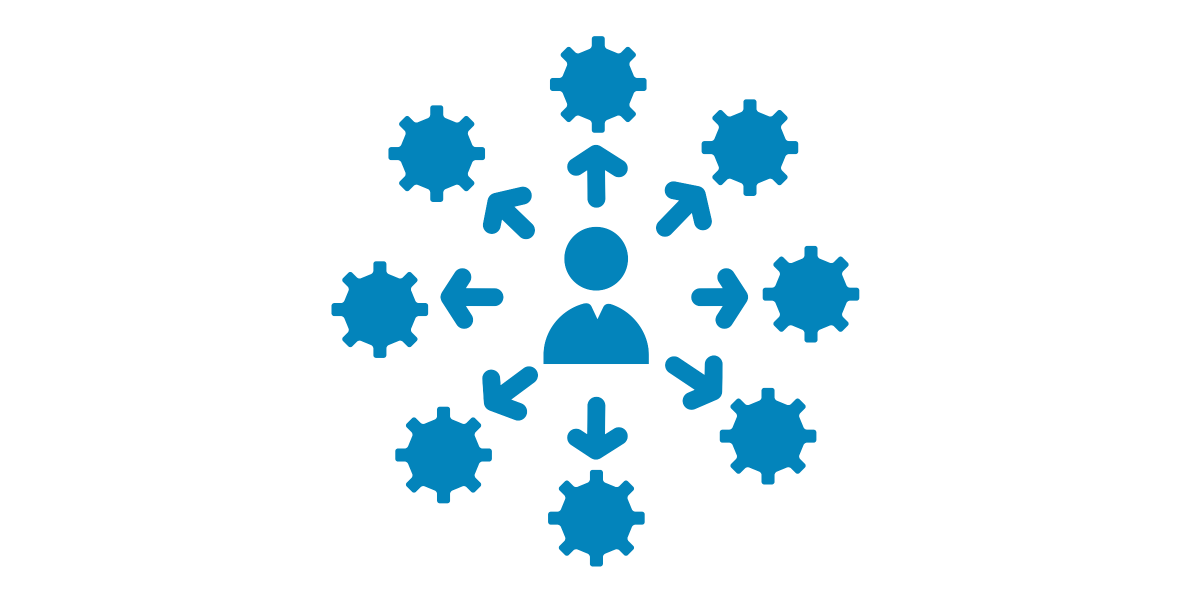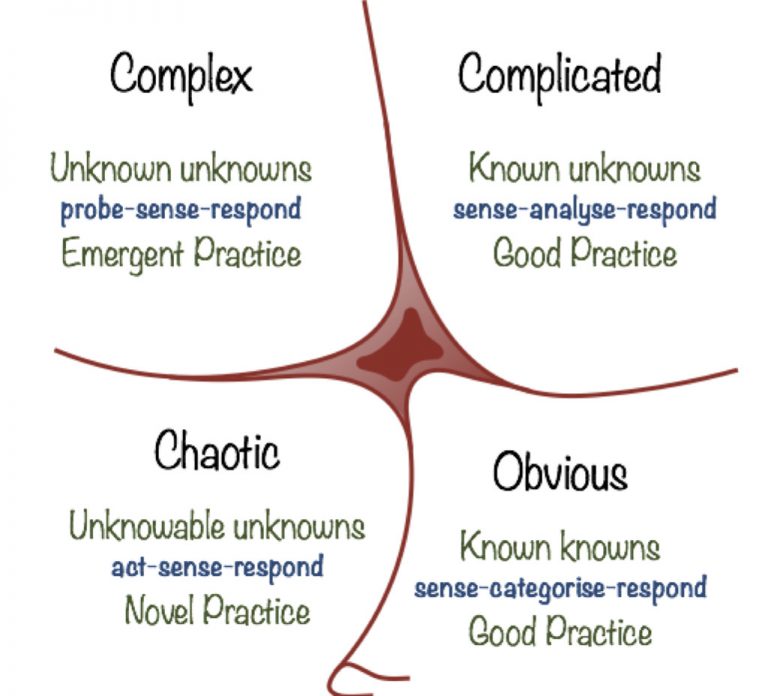
In this series, we have covered what was systemic management and why any digital leader should take a prime interest in it. In this post, we are taking the time to describe some more, where we would start and how we would deploy systemic management in practice.
Change is far from a mathematical formula. Change is “Complex” territory. By Complex, we are referring to the domain nomenclature of the Cynefin framework. If you are not familiar with Cynefin, we’ll take a minute to explain Complexity. We would also recommend that you visit Cognitive-Edge because a minute won’t do it justice. The Cynefin model separates the concepts of Complex and Complicated. Complicated belongs to the ordered domains. There is a correlation between causes and effects. As a consequence, experts will have a perfect formula that can guarantee an outcome from a set of conditions and their intervention. Complex, on the other hand, belongs to the unordered domains. Causality is not guaranteed. The environment can be volatile, and interventions may yield different results. When working with a human team system, multiple factors will influence where it goes. It is therefore presumptuous to claim that there is a set recipe for every group or that we can aim for a defined outcome from the outset. In Digital change, the complexity is even more prominent as it combines business, people, technology, all nested across the systems of the enterprise. With complex systems, you start from where you are and progress from there. As Deng Xiaoping said: “Crossing the river by feeling the stones.” Interventions are therefore customised and specific to each team system. We would try multiple options and amplify what works, phase out what does not. The rest of the article will aim to suggest patterns of approaches and possibilities. Please do not read this as a cookbook because it is not. Each situation would require its variation based on its specific context.

Cynefin framework – Dave Snowden, Cognitive Edge (under Creative Common)
Systems scope and boundaries
In most cases, the sponsor of the work would establish the system up-front. But this does not always mean that this is the right system to get involved or that it is complete. As we exposed in a previous article, Digital is bringing together business and technology. The technology itself is bringing together Development and Operations (DevOps). Agility is also connecting the hierarchy of the enterprise from executives to teams. There are a lot of moving parts. Digital requires to break down silos and create alignment. So, we would start by confirming the boundaries of the system and might take a broader perspective to define the set of systems to involve.
In a corporate environment, we could even envisage mapping the system of work using tools like Viable Systems Mapping (VSM) or if dealing with a single product/flow, a Value Stream Mapping (also conveniently abbreviated as VSM!) and its suppliers, people and customers.
Systems entry
Before any systemic work, it is necessary to understand the ins and outs of the system. Is the system aligned? Are there change edges? Are we stalling on conflict? Is everybody motivated and supportive of each other? Nothing beats conversations with the people and observations on the ground for this initial assessment.
For many managers, this initial phase is generally an edge in itself. They would consider coaching as unnecessary. “We are fine; we just need to get on with the work.” There are a couple of answers to this. First of all, systemic coaching is about facilitating purposeful progress. So, it is part of getting the work done. Second of all, we are ready to bet that not all is fine. Enterprises going through agile adoption and Digital change have to untangle much legacy and turn beliefs upside down. Start-ups that are born agile by default have to cross significant challenges once they start scaling-up and structuring. Some of those challenges can break them. And even if your system of work were just fine, in this period of Digital challenges, we would be tempted to return the question: Are you challenging self enough? Every time we have this discussion, the words the racing driver Mario Andretti ring in our heads: “If everything seems under control, you are not going fast enough”. Change is about movement, taking your system over an edge and bringing sight of the next one to cross. Change edges are healthy and needed; they are a sign that we are moving ambitiously forward.
To get back to systems entry, it is also possible to approach using a maturity assessment or a survey. Agendashift provides a handy set of curated prompts and a starter workshop to reveal the voices of the system (note: we are Agendashift partner and can run the survey and facilitate such workshops). Agendashift is extremely useful for being outcome-oriented and using questions as prompts for conversation rather than establishing an assessment score.
Developing the team spirit and reinforcing positivity
An important aspect of Digital change is shifting the dynamic from individuals to the team unit. Unfortunately, managers have not been equipped with the tools to make a team click. They put a tab down at the pub, treat the team to expensive restaurants or lavish on team entertainment during off-sites. Though those contribute to some useful soft-relationship building, getting a team to encourage positivity can be achieved much simpler and more effectively. Some education about toxic behaviours in relationship systems is a good starting point. Protocols and antidotes to toxic behaviours, team charters, appreciation circles are useful too. Research from the Gottman Institute indicates that we need a ratio of at least 5:1 positive to negative interactions to create a positive environment. It works equally at work and home (with partner and family). Management 3.0 also offers a lot of suggestions to manage for happiness. How is the team doing with this ratio? How are you doing yourself with this ratio?
Revealing voices from the system
People take a role in the team and have a voice in the system of work. Voices may be loud, quiet, enthusiastic, cynic, happy, fed-up, etc. All those voices have a meaning and emerge to create balance a the heart of a team. Even conflict is an indicator of where the system is at. Needless to say, that conflict is not a good place to be, nor one that will drive performance. Even silence tends to be indicative of something lurking below the surface.
Revealing all the voices of the system is at the core of systemic management, and many exercises can facilitate this progress. People would be familiar with “Constellations” that many coaching frameworks recommend. ORSC offers many tools and skills to manage systemically. The tools cover situations such as change, communication, collaboration, conflict management and positivity.
Systemic management is based on the fundamental belief that team systems are naturally intelligent and creative. Revealing the voices is a means to stimulate the group’s relationship systems intelligence.
Driving purposeful progress
Stimulating the team’s natural intelligence is only a part of progressing towards solutions. Systemic interventions aim to align the team, set actions and plan their deployment. In the context of digital change and transformation towards agility, we propose mixing systemic management techniques with purposeful change management frameworks and methods. For instance, we may organise an off-site with a management team to define the strategic direction of a company or a product/service line. We would use a framework like Wardley Mapping for visualising and discussing the strategy. But, how do you get this senior group in the right frame of mind to contribute to the strategic reflection? Well, they are a system, and with some education and positivity, you can unleash their creative intelligence. We can also discuss levels of reality to connect the group to the essence and ambition for the business. The intervention is purposeful, and the systemic approach energises its content. Other workshops and assistance would leverage a similar mix of change framework and systemic management. We apply this approach to multiple levels of defining, deploying, planning and executing a digital change strategy or an agile transformation initiative.
How we can help
We are entering the process of certification with ORSC. We have researched and established models of interventions in the form of workshops and direct coaching. Our offerings are suitable for strategy definition, organisation design, flow improvements, digital change management, strategy deployment and execution, operational excellence, implementation of a continuous improvement process, etc.
We are now looking for client systems to work with.
Please get in touch if interested.
Sources:
Cognitive-edge: http://cognitive-edge.com/
Agendashift: https://www.agendashift.com/
Gottman Institute: https://www.gottman.com/
Management 3.0 Kudo Cards: https://management30.com/product/kudo-cards/
ORSC – Organisation and Relationship Systems Coaching: https://crruk.com/ and https://www.crrglobal.com/

